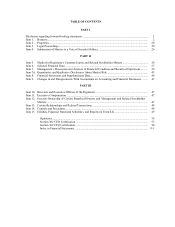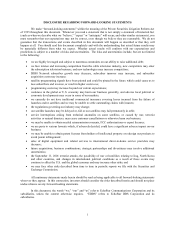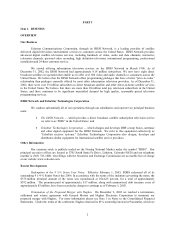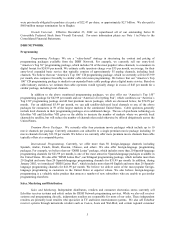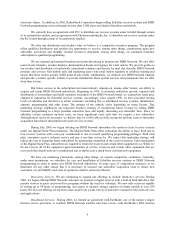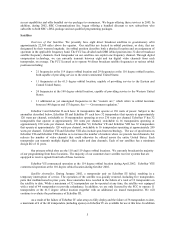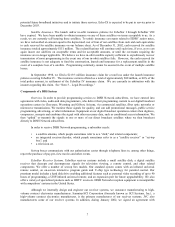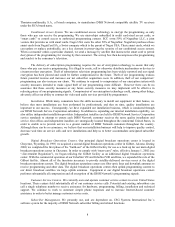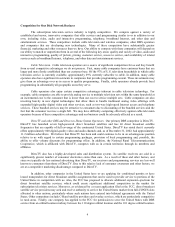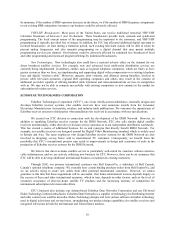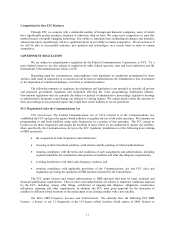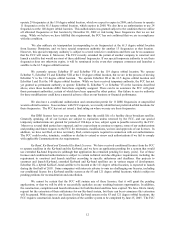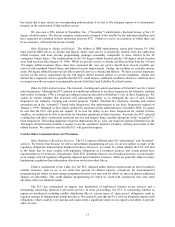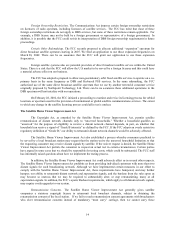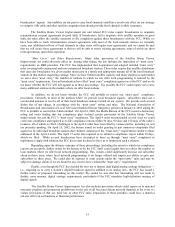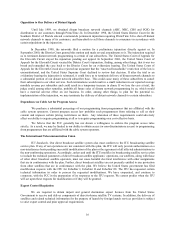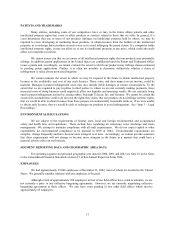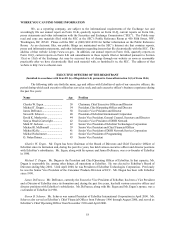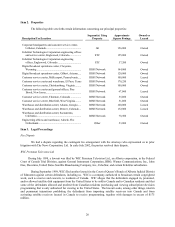Dish Network 2002 Annual Report Download - page 12
Download and view the complete annual report
Please find page 12 of the 2002 Dish Network annual report below. You can navigate through the pages in the report by either clicking on the pages listed below, or by using the keyword search tool below to find specific information within the annual report.10
In summary, if the number of DBS operators increases in the future, or if the number of DBS frequency assignments
to our existing DBS competitors increases, our business could be adversely affected.
VHF/UHF Broadcasters. Most areas of the United States can receive traditional terrestrial VHF/UHF
television broadcasts of between 3 and 10 channels. These broadcasters provide local, network and syndicated
programming. The local content nature of the programming may be important to the consumer, and VHF/UHF
programming is typically provided free of charge. In addition, the FCC has allocated additional digital spectrum to
licensed broadcasters. At least during a transition period, each existing television station will be able to retain its
present analog frequencies and also transmit programming on a digital channel that may permit multiple
programming services per channel. Our business could be adversely affected by continued free broadcast of local
and other programming and increased program offerings by traditional broadcasters.
New Technologies. New technologies also could have a material adverse effect on the demand for our
direct broadcast satellite services. For example, new and advanced local multi-point distribution services are
currently being implemented. In addition, entities such as regional telephone companies, which are likely to have
greater resources than we have, are implementing and supporting digital video compression over existing telephone
lines and digital “wireless cable.” Moreover, mergers, joint ventures, and alliances among franchise, wireless or
private cable television operators, regional Bell operating companies and others may result in the creation of
additional providers capable of offering bundled cable television and telecommunications services in competition
with us. We may not be able to compete successfully with existing competitors or new entrants in the market for
subscription television services.
ECHOSTAR TECHNOLOGIES CORPORATION
EchoStar Technologies Corporation (“ETC”), one of our wholly-owned subsidiaries, internally designs and
develops EchoStar receiver systems. Our satellite receivers have won numerous awards from the Consumer
Electronics Manufacturers Association, retailers, and industry trade publications. We outsource the manufacture of
EchoStar receiver systems to third parties who manufacture the receivers in accordance with our specifications.
We created our ETC division in connection with the development of the DISH Network. However, in
addition to supplying EchoStar receiver systems for the DISH Network, ETC also sells similar digital satellite
receivers internationally, either directly to television service operators or to our independent distributors worldwide.
This has created a source of additional business for us and synergies that directly benefit DISH Network. For
example, our satellite receivers are designed around the Digital Video Broadcasting standard, which is widely used
in Europe and Asia. The same employees who design EchoStar receiver systems for the DISH Network are also
involved in designing set-top boxes sold to international TV customers. Consequently, we benefit from the
possibility that ETC’s international projects may result in improvements in design and economies of scale in the
production of EchoStar receiver systems for the DISH Network.
We believe that direct-to-home satellite service is particularly well-suited for countries without extensive
cable infrastructure, and we are actively soliciting new business for ETC. However, there can be no assurance that
ETC will be able to develop additional international business or maintain its existing customers.
Through 2002, our primary international customer was Bell ExpressVu, a subsidiary of Bell Canada,
Canada’s national telephone company. We currently have certain binding purchase orders from Bell ExpressVu, and
we are actively trying to secure new orders from other potential international customers. However, we cannot
guarantee at this time that those negotiations will be successful. Our future international revenue depends largely on
the success of these and other international operators, which in turn, depends on other factors, such as the level of
consumer acceptance of direct-to-home satellite TV products and the increasing intensity of competition for
international subscription television subscribers.
ETC’s business also includes our Atlanta-based EchoStar Data Networks Corporation and our UK-based
Eldon Technology Limited subsidiaries. EchoStar Data Networks is a supplier of technology for distributing Internet
and other content over satellite networks. Eldon Technology designs and tests various software and other technology
used in digital televisions and set-top boxes, strengthening our product design capabilities for satellite receivers and
integrated televisions in both the international and United States markets.


